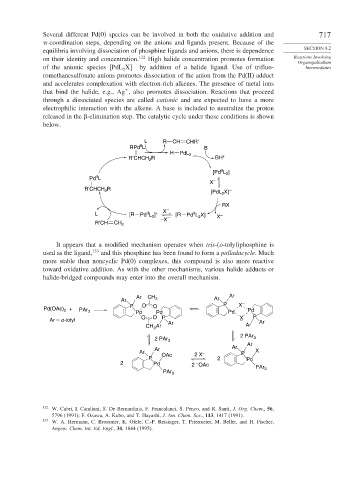Page 741 - Advanced Organic Chemistry Part B - Reactions & Synthesis
P. 741
Several different Pd(0) species can be involved in both the oxidative addition and 717
-coordination steps, depending on the anions and ligands present. Because of the
equilibria involving dissociation of phosphine ligands and anions, there is dependence SECTION 8.2
on their identity and concentration. 132 High halide concentration promotes formation Reactions Involving
Organopalladium
of the anionic species PdL X
− by addition of a halide ligand. Use of trifluo- Intermediates
2
romethanesulfonate anions promotes dissociation of the anion from the Pd(II) adduct
and accelerates complexation with electron-rich alkenes. The presence of metal ions
+
that bind the halide, e.g., Ag , also promotes dissociation. Reactions that proceed
through a dissociated species are called cationic and are expected to have a more
electrophilic interaction with the alkene. A base is included to neutralize the proton
released in the -elimination step. The catalytic cycle under these conditions is shown
below.
L R CH CHR′
II
RPd L B
H PdL 2
R′CHCH R BH +
2
0
[Pd L ]
2
II
Pd L
X –
R'CHCH R [PdL X] –
2
2
RX
–
X
II
II
L [R Pd L ] + – [R Pd L X] X –
2
2
R′CH CH 2 –X
It appears that a modified mechanism operates when tris-(o-tolyl)phosphine is
used as the ligand, 133 and this phosphine has been found to form a palladacycle. Much
more stable than noncyclic Pd(0) complexes, this compound is also more reactive
toward oxidative addition. As with the other mechanisms, various halide adducts or
halide-bridged compounds may enter into the overall mechanism.
Ar Ar
Ar CH 3 Ar
P O O P X –
Pd(OAc) + PAr 3 Pd Pd Pd Pd
2
O O P X P
Ar = o-tolyl Ar – Ar
CH Ar Ar
3
2 PAr
2 PAr 3 3
Ar
Ar
Ar
Ar OAc 2 X – P X
P 2 Pd
2 Pd 2 – OAc PAr
PAr 3 3
132 W. Cabri, I. Candiani, S. De Bernardinis, F. Francalanci, S. Penco, and R. Santi, J. Org. Chem., 56,
5796 (1991); F. Ozawa, A. Kubo, and T. Hayashi, J. Am. Chem. Soc., 113, 1417 (1991).
133
W. A. Hermann, C. Brossmer, K. Ofele, C.-P. Reisinger, T. Priermeier, M. Beller, and H. Fischer,
Angew. Chem. Int. Ed. Engl., 34, 1844 (1995).

